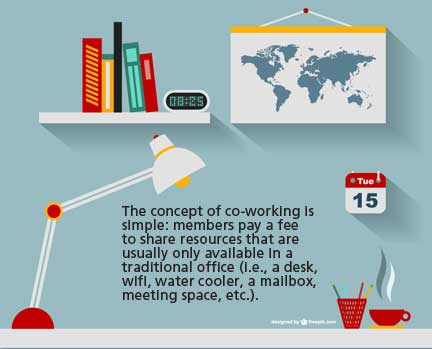Co-Mission: The Sharing Economy & The Mission World

by John Heinz
It was a Christian artist who first got us to think about creating a coworking community. She was preparing to move to Germany to work and minister through a coworking space in the heart of Berlin. We had heard of the coworking movement, but were not very familiar with the concept. Our friend suggested that we contact the founder to learn more. We did, and we were blown away by the vast new possibilities that were before us.
A friend recently shared a YouTube video on Facebook of a glacial calving. Apparently, this was the largest ever witnessed and recorded. A chunk of ice the size of Manhattan broke off of an ancient glacier and plunged into the sea with giant chards the size of the Empire State Building shooting up and down, this way and that. It was absolutely astonishing to watch. A landscape that had remained virtually unchanged for centuries suddenly became radically and permanently transformed in minutes.
Maybe it’s because I turned 40 this year. Maybe it’s because my wife and I just celebrated our tenth anniversary. Maybe it’s because I am entering into a new stage of ministry in a new city. Maybe it’s because the world seems to be finally lurching out of deep recession that has formed the backdrop of the social discourse for nearly a decade. Whatever the cause, I have been very retrospective lately about the past ten years. It seems to me that at some point over this past decade something like a giant glacial calving happened, and the world we live in today has been dramatically and irrevocably transformed.
Ten years ago, my wife and I used an atlas to navigate down the western coast of the U.S. on our honeymoon. Ten years ago, I had a separate phone, calendar, shopping list, computer, and music library. Today, all of these exist as one device I keep in my pocket. Ten years ago, I had not yet reconnected with hundreds of friends and acquaintances from childhood, nor did I keep up with all of their daily habits, job statuses, and children’s school projects. Today, at any given moment, I have access to more information than what any of the most powerful people in the world had access to just ten years ago.
Of all the profound changes over the past decade, there is one that is particularly notable. As arbitrary as the day I woke up in my 40s, the world passed its own milestone. On some undetermined day in 2008, someone somewhere moved from a rural village to a city, and for the first time in human history, the world became predominantly urban (Bloom and Khanna 2007). The global landscape was changed.
In 2013, my wife, Katheryn, and I moved to Atlanta, Georgia, to start a mission training center to help equip churches and Christian leaders for the challenges and opportunities in this changing global urban context. In the throes of the recession, we struggled to find funding, affordable space, and the resources we needed to move forward. Along the way, we began to meet many others in our city and beyond who shared a similar calling and similar limitations and difficulties. If it weren’t for the immensity of our shared obstacles, we could easily have seen each other as competitors. It was during this period, however, that we began to discover the potential and power of the sharing economy.
It was a Christian artist who first got us to think about creating a coworking community. She was preparing to move to Germany to work and minister through a coworking space in the heart of Berlin. We had heard of the coworking movement, but were not very familiar with the concept. Our friend suggested that we contact the founder to learn more. We did, and we were blown away by the vast new possibilities that were before us.
Coworking is a direct product of the economic recession over the last ten years (Cook 2009). The concept is simple: members pay a fee to share resources that are usually only available in a traditional office (i.e., a desk, wifi, water cooler, a mailbox, meeting space, etc.). Along with these shared resources, members are connected with a collaborative community of individuals within their field. The first official coworking community opened in San Francisco in August 2005 and closed less than a year later.
From 2006 to 2008, however, coworking communities began to sporadically pop up in cities around the world. Most of these catered to cash-strapped technology startups that were unable to access startup loans during the credit crunch. Sometime between 2008 and 2010, coworking took off as a global phenomenon. When we began to research coworking, there were over three thousand known coworking spaces scattered throughout nearly every major city in the world (Foertsch and Cagnol 2013). We discovered nearly forty in Atlanta alone.
By 2013, coworking began to diversify by field. There were coworking communities formed specifically for artists, small business startups, social entrepreneurs, freelance writers, and others.
Coworking itself is merely one manifestation of a much larger economic and social reorganization. Many economists are calling this emerging reality the sharing economy (2013). Several standout companies that epitomize this sharing economy are Airbnb, Uber, and Care.com. Airbnb is a website and app that easily lets you rent out your unused guest room or even an air mattress on your living room floor. Uber lets you make extra cash by using your personal vehicle as a taxi. Care.com is way to connect nonprofessional caregivers, such as a babysitter, with those in need of care.
These companies are turning their various sectors of the economy upside down, and they are doing it by facilitating the sharing of resources in a way that was impossible ten years ago. A recent article in Entrepreneur valued the size of the sharing economy at $15 billion globally, and projected it to grow to $335 billion over the next ten years (Zhou 2015).
The Importance of the Sharing Economy in Mission
So why are these “glacier-calving” changes important for the missionary venture? The world of ten years ago is gone and will not return. With every major change, there are threats and opportunities. Here are three threats and five opportunities that I predict will prove to have a disruptive and transformative influence on mission in this emerging global reality.
Threat #1: Traditional avenues for funding mission organizations will continue to dwindle in the coming years. It has become increasingly clear in the non-profit sector that the funding models that have worked for years are broken and unsustainable (Routson 2011). Even as the world economy begins to gain steam, there is little indication that things will return to how they were decades ago. Younger donors simply don’t give money the same way their parents and grandparents did.
Threat #2: The world is rapidly urbanizing and many of our mission models designed for rural communities do not translate well in multicultural urban contexts. There is a long history of deploying missionaries from culturally homogenous communities in the West to culturally homogenous communities elsewhere in the world. In the future, there will be very few culturally isolated communities. People groups will be increasingly interwoven with other groups and scattered in diaspora communities around the globe. It will be impossible to address one community without addressing the larger multicultural, urban, and global context in which they exist. If missionaries and Christian leaders are unprepared for this complexity, they will become increasingly irrelevant to the communities they seek to serve.
Threat #3: The future that is being shaped might not include us. The early adopters who were inhabiting the sharing economy are the ones who are creating the future. If the church and the mission world are unwilling or unable to engage these culture makers, we will lose our place at the table to speak into this world that is being formed.
Now, on to opportunities…
Opportunity #1: The rise of the sharing economy is a perfect opportunity to innovate new models of funding for mission. Crowdfunding, for example, is becoming a popular way to raise money for many non-profits, for-profit start-ups, social entrepreneurs, and artists. Rather than raising large amounts of money from a few people, crowdfunding leverages the Internet to raise money through small donations from a large pool of potential donors. The sharing economy has also created opportunities for sharing resources between organizations, thus reducing overhead. It has also opened up new potential tentmaking models for missionaries.
Opportunity #2: Sharing is something that Christians know how to do well, and we should feel confident to humbly lead the way. I strongly believe that sharing is a Christian value. It is what we do naturally within a healthy church community. It is also something that we do between churches and ministries, albeit awkwardly at times. We possess the biblical and theological resources as the community of Jesus to take a leadership role in the sharing economy.
Opportunity #3: The sharing economy is creating space for new models for economic development. If the industrialized economy alienated people from their work, than the sharing economy has the potential power to rejoin people to their work. The rise of the sharing economy represents a virtual return to the ancient barter system that economically sustained human beings for millennia. As members of a global village, everyone has something of value to sell or trade. There is likely existing and potentially existing technology that could be leveraged to empower communities to take their economic future back into their own hands.
Opportunity #4: Coworking can be a great missional model for global urban contexts. Not only are there coworking spaces in nearly every country and every major urban center in the world, there is also a level of interconnectivity between coworking communities. “Coworking visa” programs allow members of a coworking space in one city to enjoy a temporary membership in another space in another city while they are in town. The missional potential here is profound. Trade associations served as a conduit for the rapid expansion of the early Church throughout the urbanized Roman world (Meeks 1983, 25-32). Likewise, coworking has the potential to connect diverse individuals naturally with those who work in similar fields all around the world.
Coworking, by definition, means “working side-by-side as equals.” I have intellectually struggled with many business-as-mission models because they often set up an employer-employee relationship that lacks the equality necessary for communication of the gospel and healthy discipleship. Coworking spaces create a relatively neutral space for people with diverse cultural backgrounds to engage one another as peers, thus offering a natural context for evangelism and discipleship.
If we are truly concerned with reaching the culture makers, artists, and entrepreneurs who are creating the future, then coworking may be one of the best ways to do it. It is a naturally collaborative and creative environment. For example, there are four different coworking spaces in our building. Each has a unique constituency and market sector: one is specifically for artists, one for social entrepreneurs, one for tech startups, and our Christian training community. There is an authentic collaborative spirit between our different communities allowing the opportunity to create common events around the intersection of faith and culture.
Opportunity #5: The sharing economy provides potential models to help churches and ministries become future-oriented and innovative. Cities around the world are deliberately encouraging the development of creative clusters. These are geographical concentrations of creative individuals, companies, academics, and institutions that inspire and cross-pollinate one another to stimulate robust innovation and collaboration. City planners have discovered that with the right environment and the right ingredients, they can create a nurturing space for innovation to happen (Chapain et al 2010). I am fascinated with the potential that this clustering model could have in facilitating innovation in church and mission ministries. We can create spaces that facilitate the interaction and collaboration of innovative Christian academics, pastors, and practitioners in close proximity to other culture makers to discover new ways forward for the Church as we seek to engage and serve the world around us.
Although I have no way to predict what the world will be like in ten years, I can say with confidence that it will be profoundly different than today. The technologies that are being developed by some 20-year-old in a coworking space in Lagos or Bogota or Mumbai could transform the world of 2025 in a million unpredictable ways.
Whatever the future, however, there is One who will always remain unchanged. Our God is the same yesterday, today, and forever. He is working throughout the world to redeem his creation, and he has invited each of us to join him on this amazing adventure as his coworkers.
References
Bloom, David and Tarun Khanna. 2007. “The Urban Revolution.” Finance and Development. September. Accessed March 26, 2015, from www.imf.org/external/pubs/ft/fandd/2007/09/bloom.htm.
Chapain, Caroline, Phil Cooke, Lisa De Propris, Stewart MacNeill, and Juan Mateos-Garcia. 2010. “Creative Clusters and Innovation: Putting Creativity on the Map.” Nesta. November. Accessed March 26, 2015, from www.nesta.org.uk/sites/default/files/creative_clusters_and_innovation.pdf.
Cook, Kristina. 2009. “Co-working Has Wider Appeal in Recession.” Reuters. February 17. Accessed March 26, 2015, from www.reuters.com/article/2009/02/17/
us-coworking-idUSTRE51G49R20090217.
Foertsch, Carsten and Remy Cagnol. 2013. “The History of Coworking in a Timeline.” Deskmag. September 2. Accessed March 26, 2015, from www.deskmag.com/en/the-history-of-coworking-spaces-in-a-timeline.
Meeks, Wayne. 1983. The First Urban Christians: The Social World of the Apostle Paul. New Haven, Conn.: Yale University Press.
Routson, Joyce. 2011. “Nonprofits Must Change as Old Charitable Funding Models Decline.” Center for Social Innovation. January 31. Accessed March 26, 2015, from csi.gsb.stanford.edu/nonprofits-must-change-old-charitable-funding-models-decline.
The Rise of the Sharing Economy.” The Economist. March 9, 2013. Accessed March 26, 2015, from www.economist.com/news/leaders/21573104-internet-everything-hire-rise-sharing-economy.
Zhou, Tx. 2015. “Airbnb and Uber Are Just the Beginning. What’s Next for the Sharing Economy.” Entrepreneur. March 25. Accessed March 26, 2015, from www.entrepreneur.com/article/244192.
. . . .
John Heinz is co-director of CenterForm, a mission training center and collaborative workspace in downtown Atlanta, Georgia. CenterForm is a ministry of The Mission Society. John is also adjunct faculty at Asbury Theological Seminary and a deacon in the United Methodist Church.
EMQ, Vol. 51, No. 3 pp. 296-302. Copyright © 2015 Billy Graham Center for Evangelism. All rights reserved. Not to be reproduced or copied in any form without written permission from EMQ editors.


